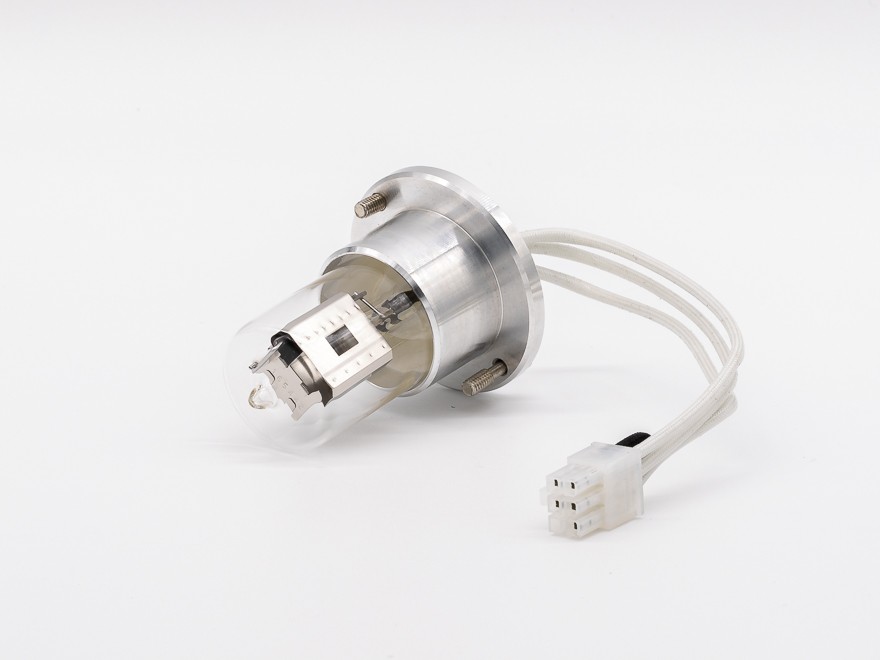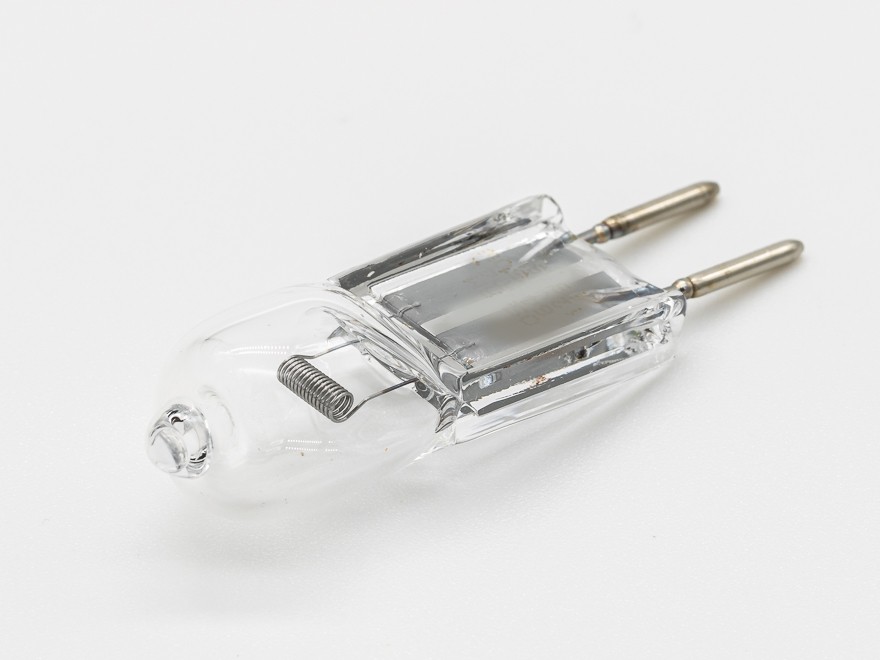
Deuterium lamps (also known as D2 lamps) are a type of arc lamp filled with deuterium. However, light is emitted only from one side and in one direction, this differs from a typical arc lamp where light is emitted in all directions. They are also an example of a gas-discharge light source, meaning they generate light by sending an electric discharge through an ionised gas (in this case deuterium).
 (Shimadzu Nexera LC2030/2040/2050/2060 D2 Lamp)
(Shimadzu Nexera LC2030/2040/2050/2060 D2 Lamp)They use a heated cathode to ensure reliable arc discharge, this means that they require warm-up time before use, which extends the necessary prep time compared to other lamps. A stable power source must also be ensured in order to maintain a constant current and temperature.
Deuterium lamps are an ideal light source for HPLC as they can emit a continuous stream of light in the UV region, with wavelengths ranging from 190 – 370 nm. This wavelength range makes Deuterium lamps ideal for high precision absorption measurements, which makes them perfect for HPLC analyses.
Xenon lamps are another example of a light source for HPLC. The advantage to a xenon lamp is that they encompass the UV region, visible region and infrared (IR) region. However, a deuterium lamp is often considered a better instrument for UV spectroscopy as they are more stable and affordable than a xenon lamp or a Mercury-Xenon lamp, making them more suitable for a lab setting.
Another example of a light source for UV spectroscopy is a tungsten halogen lamp. They have a wavelength range of 320 – 1100nm, this is suitable for UV Spectroscopy as it encompasses the visible region of 380nm – 700nm. This means that when used together with a deuterium lamp, the two combined ranges cover the necessary regions of the light spectrum.
Like deuterium lamps, they are a kind of gas-discharge light source. A tungsten halogen lamp differs from an ordinary tungsten lamp in the inclusion of a trace of halogen in the gas. Tungsten from the filament evaporates and moves to the lamp wall. Once the lamp wall reaches a heat of roughly 250c, the tungsten gas reacts with the halogen to form tungsten halide. The tungsten halide then moves back to the filament. The filament then reaches temperatures of over 2500c, this causes the tungsten and halogen to dissociate, enabling the halogen to continue this process.
 (Shimadzu UV PC Tungsten Lamp)
(Shimadzu UV PC Tungsten Lamp)The main difference between Deuterium and Tungsten Halogen Lamps is the wavelength region that they are used to measure. Deuterium Lamps are used for measurements within the UV region and Tungsten Halogen Lamps for measurements within the visible light region. Their differing wavelength regions are why both are used alongside UV vis spectrophotometers to get a wider range of measurements by covering a greater spectrum of wavelengths.
They also differ in their energy requirements. Deuterium lamps require a large and complex power supply, this means that tungsten halogen lamps are cheaper to run than deuterium lamps.
Deuterium lamps have a finite lifetime. The average operating life for a deuterium lamp is roughly 2000 hours. Towards the end of life, general wear and tear will cause issues such as the metal coating of the lamp evaporating.
The lamp life will be impacted by a range of factors including how often it’s used. While it isn’t advisable to leave the lamp on continuously, as this can decrease its useful life by roughly three times, it isn’t recommended to ignite it repeatedly as this can also increase stress on the filament. The best practice is to turn the lamp off when it isn’t being used for extended periods of time.
As the tungsten halogen lamp approached the end of its useful life, the tungsten filament will be thin. Eventually, it will get so thin the surge of current will cause mechanical stress resulting in the filament snapping.
For someone with an experienced eye, it can be easy to see the signs that a lamp is coming to the end of its life. Getting a service from the technicians at LC Services can allow you to spot the signs of damage early, enabling you to purchase a replacement in advance. This can prevent delays to your process by ensuring that you always have the correct instruments in full working order. Not only can LC Services service your instruments, they can also provide a new lamp when your lamp does reach the end of life.
In High-Performance Liquid Chromatography (HPLC) molecules are separated based on characteristics such as size, polarity, absorption etc. The final stage of HPLC is detection, in this stage the characteristics of the molecules are identified. By using ultraviolet (UV) spectroscopy in the detection stage of HPLC, the concentration of molecules can be measured. By measuring the amount of light a molecule absorbs, the concentration of a solution can be calculated. This is because Beer Lambert Law states that there’s a linear relationship between a solution’s concentration and its absorption.
During the detection stage of HPLC – after the sample has been eluted- lamps are used as light sources for ultraviolet spectroscopy. Deuterium lamps and tungsten halogen lamps are used with each other (alongside a UV vis spectrophotometer) as they encompass the entire UV and visible light regions when combined for accurate analyses.
If you want to find out more about chromatography services or our range of deuterium and tungsten lamps, don’t hesitate to get in touch with our team, here.
